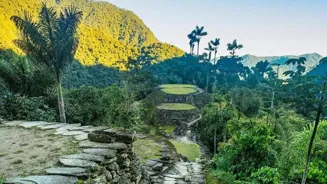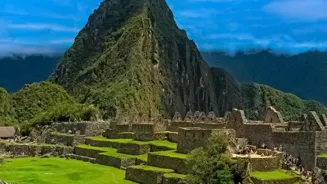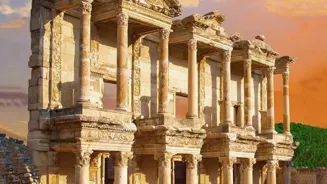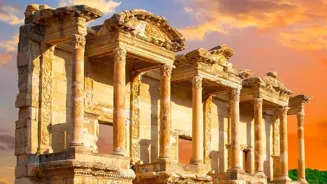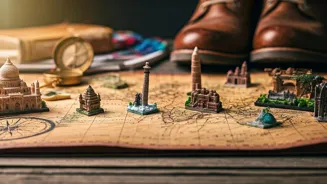Unveiling Ancient Marvels: Journey Through Time With 8 Captivating Sites. Discover the secrets of bygone eras!
India, a land of vibrant culture and rich history, boasts a treasure trove of ancient ruins.
These sites aren't just piles of old stones; they are windows into forgotten eras, whispering tales of empires, art, and everyday life from centuries past.
For history buffs and curious travelers alike, exploring these locations is like stepping into a time machine. Get ready to embark on a journey through India's captivating past, as we unveil eight incredible sites that will transport you back in time.
Explore the majestic ruins of Hampi, a UNESCO site embodying the grandeur of a glorious empire
Our first stop is the magnificent ruins of Hampi in Karnataka. Once the capital of the Vijayanagara Empire, Hampi is now a UNESCO World Heritage site that will leave you breathless. Imagine a city sprawling across a landscape of giant boulders, with temples, palaces, and bustling marketplaces.
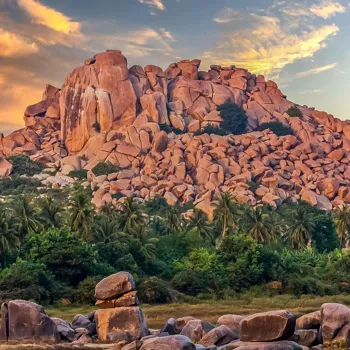
The Virupaksha Temple, still actively used for worship, stands as a testament to the city's enduring spiritual significance. The Vittala Temple, famed for its iconic stone chariot, is a masterpiece of Vijayanagara architecture.
Exploring the Queen's Bath, the Lotus Mahal, and the Elephant Stables provides fascinating insights into the royal life and the city's advanced infrastructure. Walking through Hampi, you can almost hear the echoes of a vibrant, powerful empire that once thrived here.
The intricate carvings on the temple walls depict scenes from Hindu mythology, showcasing the artistic talent of the artisans.
Hampi is not just a collection of ruins; it's a living museum that transports you to a golden age of art, architecture, and culture, letting you experience the grandeur of a bygone era.
Explore ancient Mohenjo-daro: a testament to Indus Valley Civilization's urban sophistication
Next, we journey to the ancient city of Mohenjo-daro in Sindh, Pakistan but a crucial part of undivided India's past. This site, along with Harappa, forms the backbone of the Indus Valley Civilization, one of the world's earliest urban societies.
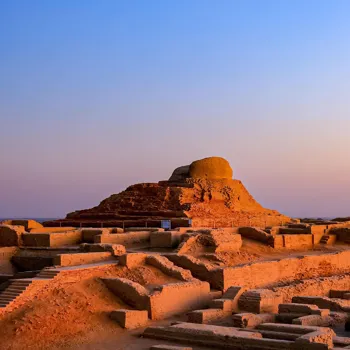
Dating back to around 2500 BCE, Mohenjo-daro showcases remarkable urban planning and engineering skills. The Great Bath, a large public bathing tank, is a testament to the city's sophisticated water management system.
The well-organized streets, houses with private wells and bathrooms, and the advanced drainage system reveal a society that valued hygiene and order. The discovery of artifacts like pottery, seals, and tools provides valuable insights into their daily life, trade, and artistic abilities.
Mohenjo-daro stands as a powerful reminder of the advanced civilizations that flourished in the Indian subcontinent thousands of years ago. It tells a story of a people who built a thriving urban center, demonstrating a remarkable understanding of urban planning and sanitation.
It's a place where you can connect with the roots of civilization in the Indian subcontinent, learning about the lives of its early inhabitants and their contributions to the world.
Nalanda Mahavihara: Ancient hub of learning in Bihar with rich intellectual legacy
Then we have the Nalanda Mahavihara in Bihar, a renowned ancient center of learning. This monastic university attracted scholars from across Asia and the world.
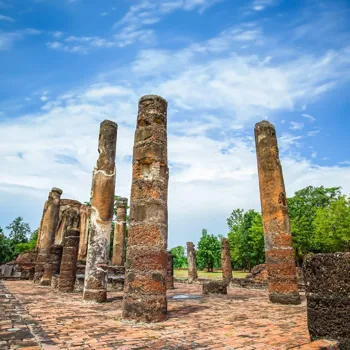
Founded in the 5th century CE, Nalanda flourished for over 700 years, becoming a beacon of knowledge in Buddhist philosophy, medicine, grammar, and other subjects. The ruins reveal a well-organized complex of classrooms, dormitories, temples, and libraries.
Imagine thousands of monks and scholars engaged in debates and discussions, shaping the intellectual landscape of their time. The Chinese traveler Xuanzang spent years at Nalanda, studying and collecting Buddhist scriptures.
The site offers a glimpse into the rich intellectual and spiritual traditions of ancient India, underscoring the country's historical role as a center of learning.
Walking through the ruins, you can almost feel the weight of history and the energy of countless scholars who dedicated their lives to the pursuit of knowledge.
Nalanda stands as a testament to the importance of education and the enduring legacy of ancient Indian scholarship, offering a profound connection to our intellectual and spiritual heritage.
Exploring Ajanta Caves: Ancient Buddhist art masterpiece in Maharashtra
Let's move ahead to the Ajanta Caves in Maharashtra, a UNESCO World Heritage site. These rock-cut cave temples showcase exquisite paintings and sculptures depicting Buddhist religious art. Carved into the cliffside, the caves date back to the 2nd century BCE to the 5th century CE.
The murals and frescoes illustrate the Jataka tales, stories of the Buddha's past lives, and various scenes from his life. The intricate details and vibrant colors of the paintings, created using natural pigments, are a testament to the artistic mastery of the ancient painters.
The sculptures depict various deities, bodhisattvas, and scenes from daily life. Visiting the Ajanta Caves is like stepping into a gallery of ancient art, where you can marvel at the skill and creativity of the artists.
The paintings offer a unique window into the beliefs, values, and artistic sensibilities of the time. The Ajanta Caves are not just a collection of art; they are a powerful expression of spirituality and artistic achievement that speak to the heart.
Ellora Caves: Fusion of Buddhist, Hindu, Jain art in Maharashtra
Next will be the Ellora Caves, also in Maharashtra, another UNESCO World Heritage site. Unlike Ajanta, which is primarily Buddhist, Ellora represents a fusion of three religions: Buddhism, Hinduism, and Jainism.
The 34 caves, carved out of a single basalt cliff, showcase a remarkable range of architectural styles and artistic expressions. The most famous is the Kailasa Temple, carved out of a single rock, representing Mount Kailash, the abode of Lord Shiva.
The intricate carvings and massive scale of the temple are breathtaking. The Buddhist caves feature sculptures of the Buddha and bodhisattvas, while the Jain caves depict scenes from Jain mythology. The Ellora Caves symbolize religious harmony and the artistic brilliance of ancient India.
This site offers a unique perspective on the coexistence of different religious traditions and the artistic achievements of ancient Indian civilization, showcasing the creativity and skill of the artisans who shaped the caves.
Lothal in Gujarat showcases advanced engineering of Indus Valley Civilization
Finally, we have the Lothal in Gujarat, an important port city of the Indus Valley Civilization. Excavations at Lothal have revealed a sophisticated dockyard, indicating the city's role in maritime trade. The well-planned streets, houses, and drainage system point to an organized urban center.
Artifacts like beads, pottery, and tools provide insights into the daily life and economic activities of the people. Lothal highlights the advanced engineering and urban planning skills of the Indus Valley Civilization, showcasing their contributions to maritime trade and urban development.
Exploring Lothal allows you to connect with the industrious people who built a thriving port city, contributing to the economic prosperity of their civilization.
It's a place where you can learn about their skills in shipbuilding, trade, and urban planning, and appreciate their contribution in shaping the ancient world, linking India to the larger network of civilizations during that time.
AI Generated Content. Glance/InMobi shall have no liability for the content